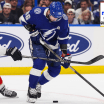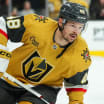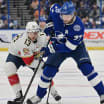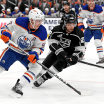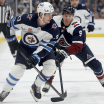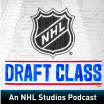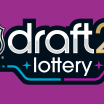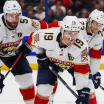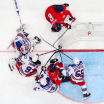NHL.com is providing in-depth analysis for each of its 30 teams throughout August. Today, the biggest reasons for optimism and the biggest questions facing the Philadelphia Flyers:
The Philadelphia Flyers finished strong last season, going 16-6-3 in their final 25 games and winning the second wild card into the Stanley Cup Playoffs from the Eastern Conference.
They lost to the Washington Capitals in six games in the first round, and general manager Ron Hextall had a mostly quiet offseason, partly because he believes the roster he assembled is capable of more.
Reasons for optimism, questions facing Flyers
Jakub Voracek needs to bounce back; defense must allow fewer shots
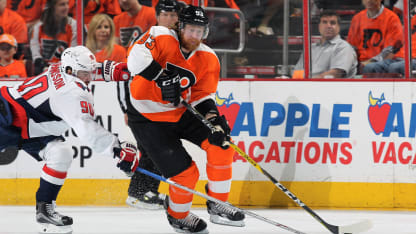
© Len Redkoles/Getty Images
Flyers 30 in 30: Season outlook | Top prospects | Fantasy outlook
"I've been pounding that for two years, that we need to draft and develop and we need to get better from within," Hextall said. "It's on a number of our players to be better hockey players than they were a year ago."
Here are four reasons for optimism entering this season:
1. Brayden Schenn on the rise
Schenn, 24, had a breakout season in 2015-16, setting NHL career bests in goals (26), assists (33), points (59), power-play goals (11) and power-play points (22).
In the past three seasons, he's one of 10 forwards 25 or younger with at least 18 goals and 40 points in each season, according to HockeyReference.com.
"Brayden is a very good young player who has continued to get better and we hope he continues to get better," Hextall said. "The good thing for us and Brayden is he's gotten better every year. He's a hard worker and he's starting to figure out some of the little intricacies of the game. He had his best year to this point this past season, so hopefully he continues to build on that. I believe he will."
2. Stability in goal
Whatever struggles the Flyers had last season, goalies Steve Mason and Michal Neuvirth rarely were to blame.
The Flyers allowed 30.7 shots per game, eighth-most in the League; among teams that made the playoffs, only the Chicago Blackhawks allowed more (30.8).
But the Flyers had the second-best even-strength save percentage in the League, .933, one percentage point behind the New York Rangers. And Mason's stellar play down the stretch was the biggest reason the Flyers made the playoffs. He started 16 of 17 games from March 5 and April 9 and was 10-4-3 with a 2.14 goals-against average and .924 save percentage.
Neuvirth was limited to 32 games because of injury, but his 18 wins were the second-most of his NHL career, and among goalies to play at least 30 games, his .924 save percentage was tied for fourth in the League and his 2.27 GAA tied for seventh.
3. A strong prospect pipeline
The Flyers have enviable young depth on defense that started its arrival last season with Shayne Gostisbehere, a 2012 third-round pick (No. 78) who was runner-up for the Calder Trophy.
From 2013 to 2015 they used three of their four first-round picks on defensemen, and Samuel Morin, Travis Sanheim and Ivan Provorov all have the look of a future NHL contributor. In 2015-16, Morin had a solid first pro season with Lehigh Valley of the American Hockey League, Provorov was named the top defenseman in the Canadian Hockey League and Sanheim ranked fourth among Western Hockey League defensemen with 68 points.
The Flyers are solid at other positions too; center Travis Konecny, the 24th pick in the 2015 draft, had 30 goals and was tied for eighth in the Ontario Hockey League with 101 points. Carter Hart, a 2016 second-round pick (No. 48) was the top goaltender in the CHL. Right wing Nicolas Aube-Kubel (2014 second-round pick, No. 48) had 38 goals in 61 games with Val-d'Or of the Quebec Major Junior Hockey League.
4. Dave Hakstol, year two
In his first NHL season, Hakstol answered any questions about his ability to coach pros by getting the Flyers to the playoffs. Hextall is expecting more success this season from the former UIniversity of North Dakota coach.
"I think the biggest thing is the players now know the expectations and the expectations are high," Hextall said. "That's a good thing. We expect every player to come in in good shape and play close to the top of their ability over the course of the year, and that's not unfair. I think Dave is very consistent with his message. He backs it up because he works as hard as any player."
Here are three key questions facing the Flyers:
1. Where will offense come from?
The Flyers were 22nd in the League last season at 2.57 goals per game, second-fewest among teams that made the playoffs.
The biggest addition to the forwards was the signing of Dale Weise, who had 14 goals in 71 games with the Montreal Canadiens and Chicago Blackhawks last season. He had one goal in 19 regular-season and playoff games with the Blackhawks.
The Flyers clearly are counting on returning players to step up their play, among them Sean Couturier. In 63 games last season he had 39 points, tying his previous NHL best set in 82 games in 2013-14. Part of his growth was being used in more offensive situations; he started 44.63 percent of shifts in the offensive zone last season, the most in his five NHL seasons.
"We were looking for growth from him and he showed growth," Hextall said. "If you look at his points per game, just the push that he put in offensively, that's what we were looking for. … Hopefully he can take another step this year."
2. Is the defense any better?
The six defensemen who played for the Flyers in their final playoff game last spring are signed for this season, and they'll also have Michael Del Zotto, who didn't play after Feb. 13 because of a wrist injury. However, the Flyers were 23rd in the League allowing 30.7 shots per game last season.
The Flyers are strong in defense prospects, with Provorov and Sanheim close to being NHL ready. But they'll have to show they can help immediately for the Flyers to keep them on the roster.
"The most dangerous thing is depending on your kids to be ready and then all of a sudden they're not ready and you're sitting there in early October and wondering 'What do we do now?'" Hextall said.
3. Can Jakub Voracek bounce back?
Voracek had 11 goals and 55 points last season, after he was fourth in the League with 81 points in 2014-15.
He started slowly and compounded things by working too hard to live up to the eight-year contract he signed in July 2015. A midseason move to left wing from his natural right wing spot seemed to invigorate him, but Voracek missed three weeks with a foot injury sustained Feb. 25 and never got going again. He had one goal and six assists in 13 games after returning to the lineup March 19.
Hextall said he has no doubt Voracek can get back to his 2014-15 form this season.
"I'm sure there will be a lot of growth from Jake from last year," he said. "Sometimes you've got to struggle or maybe not play up to your potential to realize what you're doing to play your best. He learned some valuable lessons last year. It wasn't like he was terrible; he just wasn't as good as he was the year before and wasn't as good as he can play. Jake's going to become a more well-rounded hockey player and athlete as a result."
